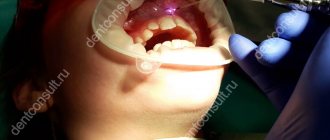When are teeth filled?
As a rule, a filling is placed after depulpation during diseases such as:
- caries;
- periodontitis;
- pulpitis.
The choice of filling installation method will directly depend on the specific case and is determined by the treating dentist. A professional specialist never installs a filling without first taking care to relieve inflammation after treatment. The filling is placed on a healthy tooth - if the treatment was not good enough, the disease will soon make itself felt again.
Symptoms for which people consult an orthopedic dentist
Consultation with a specialist is necessary if the following symptoms are present:
- absence of any number of teeth in a row (as a result of planned removal, loss, after injury, etc.);
- partial or almost complete destruction of the enamel and walls of the tooth;
- diagnosed diseases of the gums or jaw bones;
- increased (and in some cases painful) tooth sensitivity;
- various types of TMJ disease (temporomandibular joint);
- cosmetic defects (in particular, irregular shape, pigmentation and other disorders that spoil the aesthetics of the smile).
A dental therapist or other highly specialized specialist can diagnose problems that should be addressed specifically by an orthopedic dentist after an initial examination and consultation.
You might be interested in:
Pulpitis
Dental restoration
Treatment of caries
Dental treatment
Preparing for dental fillings
Preparation is carried out in several main stages, the purpose of which is to minimize the risk of foreign substances entering the tooth and reduce the patient’s pain from the procedure. The dentist is required to check each tooth canal for the presence of foreign contaminants, as well as the absence of inflammation or other disease that could cause it.
When preparing, the doctor adheres to a strict sequence of actions:
- Elimination of damaged and dead tissue.
- Depulpation.
- Acquaintance with the anatomy of dental canals, measuring their main parameters: length, width.
- Pre-treatment of the canals as preparation: this will expand them and be ready for filling.
- Sealing the canals with a special hermetic material.
All of the above actions are taken by the dentist exclusively while the patient is under local anesthesia.
Dental microscope for filling
This device is an irreplaceable thing in certain cases when:
|
A microscope and other optics allow the dentist to take a closer look at the problem in order to best solve it: often incorrect actions of your previous attending physician can negatively affect new procedures if you are not careful enough to notice the problem in time.
Quite often, upon close examination, it turns out that mistakes were made in installing the seal or its depressurization was detected - these are sure signs of incorrect treatment.
Which dentist treats caries?
In dental practice, 3 specialists can fill teeth at once:
- Dentist;
- therapist;
- pediatric dentist.
The job description of the first professional includes a wide range of responsibilities. He chooses treatment tactics, administers anesthesia, diagnoses, prevents and treats caries. However, this specialization does not require lengthy training in higher education institutions.
Important! Today, the profession of a dentist is considered obsolete. Their main responsibilities are handled by junior medical staff. Therapists are responsible for diagnosis and treatment.
The pediatrician can also place fillings. However, its focus is the elimination of oral diseases in children.
The dentist-therapist is the first one who receives and examines the patient. This is a generalist. If only conservative intervention is required, it will be handled by a therapist. But when specific therapy is needed, he will refer you to another doctor: an orthodontist, a prosthetist, a surgeon, a periodontist.
Additional Information! A dentist of any specialization is familiar with all manipulations. Therefore, it is not always important which doctor puts the fillings. The procedure may be necessary when performing work of a different nature: prosthetics, orthodontic treatment and other manipulations.
Materials for filling
After examining the dental canals and carrying out all the necessary treatment procedures, the dentist will have to choose the right material for the future filling. They differ in their elasticity, purpose and properties. Some fillings can disinfect the area nearby, thereby preventing a new disease, while others can only correct the tooth, relieving the patient of discomfort and the entry of food particles into the root canal.
Among the most popular mixtures:
- Gutta-percha
- fills the canals well and is quite elastic, but has shrinkage; - AH-plus
- has an antimicrobial effect, wear-resistant; - Metapex
- has an antibacterial effect; - Akrosil
- often used with gutta-percha; - Forfenan
- is not used for front teeth, as it can stain them, but has a good antibacterial effect.
Today, dentists rarely use only one mixture when installing a filling: this approach is considered ineffective due to the individual characteristics of each solution.
How is the diagnosis performed at the initial appointment with an orthopedic dentist?
Modern dentistry allows almost all manipulations to be performed painlessly for the patient. At the same time, some people who have had bad experiences in the past are afraid of visiting clinics. Most often, they prefer to know in advance what a specialist will do in order to mentally prepare not only for the procedures, but also for the initial examination, during which the diagnosis is made. If you are planning to visit a prosthetist for the first time, be prepared for the following stages of interaction:
- Basic: Questioning to collect anamnesis
. Here the specialist asks questions that will help you individually choose a method for solving the problem. - Facial examination
. To study the size of the mouth gap, possible shortening of the lower part of the face and asymmetry, features of the setting of the lips and chin. The tone of the lip muscles is also determined by palpation. - Oral examination
. The bite, shape, size and condition of existing teeth are carefully examined. The condition of the mucous membrane, the individual nuances of the formation of the frenulum of the lips are also assessed, the shape and span of the tongue, the arch of the hard palate and the general development of the jaws are studied. - X-ray
. Radiography allows you to assess the condition of the supporting units, as well as identify the presence of impacted and other special elements that cannot be detected without photographs.
(may be needed for a deeper study and accurate diagnosis):
- functional chewing samples are taken;
Based on the results of the main and additional examination, the specialist makes a diagnosis and develops individual treatment tactics. Knowing who an orthopedic dentist is, in what cases you should contact him and what he will do when you arrive at your appointment, visiting dentistry will not be so scary. And since the initial examination is absolutely painless and without discomfort, it makes sense to at least sign up for a consultation in order to understand the condition of your teeth and whether it is possible to save those about which you have complaints.
How can you tell if the filling is installed properly?
To check the installed filling, an additional photograph must be taken, which should show how well the dentist’s work was done. The filling material is highlighted in white, so even a person who does not understand dentistry can understand the picture. Each dental canal should be evenly filled with mixture from start to finish, and there should be no blurring, obvious holes or voids, or foreign objects, which could be a broken instrument.
Carefully check the quality of the work performed, because this is the key to the health of your teeth!
Techniques used by an orthopedic dentist
Already knowing what an orthopedic dentist treats, it’s time to understand what techniques he uses to achieve his goals. Today there are three of them:
- Microprosthetics
. Suitable for cases where the patient has only cosmetic defects and there is a high degree of preservation of the tooth (only the upper part is damaged). To implement microprosthetics, the following are used:- Veneers
. Designed to adjust the appearance of the tooth in color and shape. Ideally mask enamel defects and slight curvature. They are thin plates that are attached to the front of the teeth using special glue. The average service life is about 10 years. - Lumineers
. The design and method of use/installation are similar to veneers, but thinner. Their installation does not require preliminary grinding of all tooth enamel. - Tabs
. Unlike veneers and lumineers, they are used not on the front teeth, but on the chewing teeth. They are visually similar to fillings, but are made not from composite materials, but from ceramics. - Removable prosthetics
. Orthopedic structures for this type of prosthetics are a nylon or plastic base with securely attached artificial teeth. There are two types of such prostheses:- full
(over the entire jaw with complete edentia); - partial
(similar to “bridges”, but they can be removed from the mouth independently). - Fixed prosthetics (permanent)
. This type of prosthetics involves the use of:- Coronok
. Acts as an alternative to filling and artistic restoration. Used in cases of significant tooth decay. They are cap-shaped structures that completely or partially cover the tooth being prosthetized. They are made of metal, metal-ceramics, plastic and a combination of metal and plastic. - Bridge prostheses
. They are used in cases where several teeth in a row are missing in a row. They are structures consisting of two supporting crowns (placed on supporting units) and a “bridge” with artificial teeth located between them. - Implants.
A completely artificial structure, part of which is implanted into the bone tissue of the jaw (over time, complete engraftment/fusion occurs). They consist of artificial roots on which an artificial tooth is placed (screwed).
Such prostheses are attached using clasps (semicircular locks), suction cups, or glue (depending on the type of prosthesis).
Now you know what an orthopedic dentist treats and what modern techniques he uses for this. Don’t aggravate existing dental problems - plan to schedule a consultation with a prosthetist soon to learn more about how exactly your individual issues can be solved.
Consequences of poor quality filling
A poorly filled tooth can not only cause an acute reaction of the body, but also a new infection, often with subsequent complications.
What does a bad filling mean?
- inflammation;
- flux and fistula;
- loss of filling;
- change in tooth color;
- allergy to the filling material;
- cyst and granuloma;
- exit of material beyond the root tip.
If you feel acute discomfort after installing a filling, be sure to contact your dentist! Timely consultation with a professional can save you from unpleasant diseases, which are accompanied not only by continuous pain, but also by high costs for their treatment.
Who is a periodontist?
A periodontist is a highly qualified dentist with a higher medical education who specializes in the correction and prevention of pathologies of soft tissues that fix segments in the jaw bone. The concept of “periodontium” includes:
- mucous membranes that line the surface of the mouth;
- soft gum tissue surrounding the segments;
- periodontium is a thin layer of connective tissue between the alveolar process and the cementum of the tooth;
- dental cement - mineral tissue surrounding the root;
- alveolar process - a dental bed penetrated by capillaries and nerve endings.
Installing a filling on a tooth: indications
It is recommended to put a filling in dentistry mainly for caries. This is a pathological process that consists of the slow, gradual destruction of tooth tissue under the influence of bacteria contained in soft plaque. As a result of their vital activity, these bacteria produce acids that destroy calcium in tooth enamel. The enamel becomes fragile and is destroyed, forming carious cavities, which, without proper treatment, gradually increase more and more.
By installing a filling on a tooth, you can restore a crown that has been destroyed by caries by about a third. If the tooth tissues are more damaged, then other methods of their restoration are used.
However, caries is not the only reason to get a filling in dentistry. Filling can also correct:
- cracks and chips of enamel;
- traumatic injuries;
- erased enamel (with bruxism).
Where can you go in Ivanteevka if you have gum disease?
If you need the help of a periodontist, you can contact the Sanident dental clinic, one of the best in Ivanteyevka, as confirmed by reviews from our satisfied patients. We employ only professionals with extensive experience who use modern treatment methods, the best equipment and reliable drugs. With us you can quickly and inexpensively restore health to your teeth and gums.
Complex dentistry "Sanident" is located at the following addresses:
- Ivanteevka, st. Novoselki, 4 (Ivanteevka railway station);
- Shchelkovo, st. Central, 80 (railway station Voronok).
What types of fillings are there?
There are several types of filling materials. The type of material determines the cost of installing a filling on a tooth, how long it will last, and how good it will look.
- Cement fillings have been popular for some time now due to their low cost and ease of use. The main disadvantage of dental cement is its short service life (up to 2 years), as well as its adverse effect on tooth tissue (they can gradually collapse around the filling).
- Plastic fillings are another simple and cheap way to restore a tooth. However, plastic changes color over time and shrinks greatly, ceasing to perform protective functions.
- Composite fillings are the best inexpensive filling option. They have acceptable aesthetics and can last up to 3-5 years.
- Light-curing fillings are one of the most modern and technologically advanced filling methods: the polymer hardens in the light of an ultraviolet lamp. You can quite accurately match the color of the filling to the color of the enamel and make it almost invisible. Yes, these fillings have the highest price, but putting a filling made of photopolymer means solving the issue of restoring a tooth for 5 years or more.
At the ViDentis clinic, patients are offered high-quality light-curing fillings made in America, Japan and Germany.
Anesthesia for the treatment of childhood caries
Local anesthesia. Used in the vast majority of cases. There are 2 types: application and injection anesthesia. The first does not involve an injection. The risk here is that the child may swallow saliva containing lidocaine. Injections are safer and more effective.
Anesthesia. Used if the child is restless or simply afraid to have their teeth treated. This method is common in the West. Many parents are afraid of memory impairment due to general anesthesia. However, this happens extremely rarely. In addition, general anesthesia becomes the only option when you need to fill several teeth at once in one trip to the dentist. After all, this can take 2 or more hours. Before general anesthesia is administered, the child must undergo the following tests:
- Blood biochemistry.
- General blood and urine analysis.
- Electrocardiography.
- Blood for sugar.
Before the introduction of general anesthesia, you cannot eat for 6 hours, and drink for 4 hours. The child is gently put to sleep using a sedative gas containing sevoflurane. To wake him up, it is enough to increase the oxygen supply. This can be done at any time. After recovery from anesthesia, all reflexes are restored within the first 15 minutes.
Chemically cured composites
The main property of chemically cured composites for fillings is their polymerization exclusively when exposed to certain substances. That is, such materials harden evenly after mixing their original components. This makes the filling process more controlled and of high quality, especially when it comes to very deep cavities or extensive carious lesions.
The disadvantages of this material for fillings include the following:
- insufficient resistance, especially under systematic mechanical influence;
- rapid pigmentation and high probability of darkening.
In this regard, such fillings are used less frequently compared to photopolymers.











